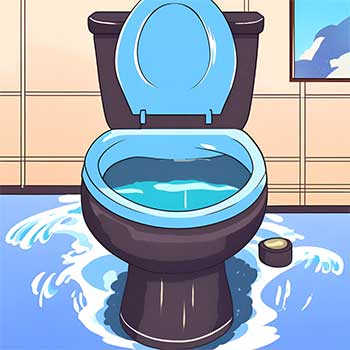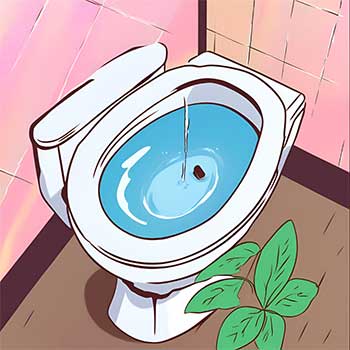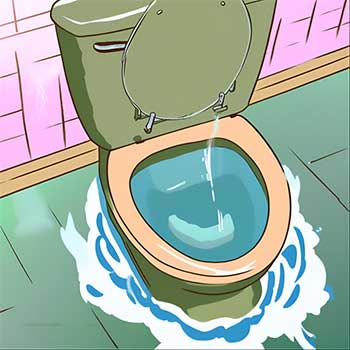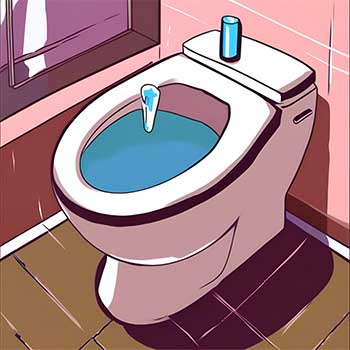You’ve just flushed your toilet, and instead of seeing the water swirl away swiftly, it fills up almost to the brim and then, ever so slowly, it starts to drain. I bet you’re scratching your head wondering what on earth is going on. Don’t worry, you’re not alone.
This is a common issue that can be quite baffling. But fear not, because by the time you finish reading this, you’ll understand why this happens and what you can do about it.
Understanding the Problem: What’s Happening Inside Your Toilet?

Let’s kick things off by breaking down what’s happening when your toilet fills up with water and then drains slowly.
In an ideal scenario, you flush the toilet, the water in the bowl gets replaced with fresh water, and all the waste gets whisked away down the drain.
Simple, right?
But when something’s off, this smooth operation gets disrupted.
Here’s the deal: the slow draining issue typically points to a blockage somewhere in your plumbing system.
This could be in the toilet itself, in the pipes that lead away from it, or even further down the line in the sewer system.
When there’s a blockage, water can’t flow freely, causing it to back up temporarily before it slowly seeps past the obstruction.
Spotting The Culprit: Common Causes Of A Slow Draining Toilet
Okay, so now that you have a basic idea of what’s happening, let’s delve into some specific reasons why your toilet might be acting up. Understanding these causes can help you pinpoint the issue and figure out how to fix it.
- Clogged Toilet Trap
The toilet trap is a curved section of the toilet’s drainpipe that holds a small amount of water to prevent sewer gases from entering your home. This trap can easily get clogged with toilet paper, sanitary products, or other debris.
When this happens, the water can’t pass through quickly, causing it to back up and drain slowly.
- Blocked Vent Pipe
Your plumbing system has vent pipes that allow air to enter the pipes, ensuring that wastewater flows smoothly. If these vents get blocked by leaves, debris, or even bird nests, it can cause a vacuum effect, which slows down the draining process.
This blockage can be tricky to spot because it’s not immediately visible.
- Sewer Line Obstructions
Sometimes, the issue isn’t with your toilet or the immediate pipes but further down the line in your sewer system. Tree roots can invade sewer lines, or debris and buildup can cause a significant blockage.
When the main sewer line is obstructed, it affects all the drains in your house, including your toilet.
- Hard Water Deposits
If you live in an area with hard water, mineral deposits can build up in your pipes over time. These deposits narrow the pipes, restricting water flow and causing slow drainage. This issue doesn’t happen overnight but gradually worsens, eventually leading to noticeable problems.
Diagnosing The Issue: How To Identify The Root Cause?
Now that we’ve covered some common causes, you’re probably wondering how you can determine which one is plaguing your toilet. While some issues might require a professional plumber, there are a few things you can check on your own.
- Check Other Drains

First, check if the problem is isolated to your toilet or if it’s affecting other drains in your house.
Run water in sinks, showers, and other toilets.
If multiple drains are slow, it’s likely a sewer line issue.
If it’s just your toilet, the problem is more localized.
- Look for Visible Blockages
Peek into the toilet bowl and the visible part of the toilet trap.
Sometimes, the blockage is near the surface and can be easily removed with a plunger or a toilet auger.
Be sure to use a flange plunger, which is designed for toilets, to create a better seal and more effective plunging.
- Inspect the Vent Pipe
If you’re comfortable getting up on your roof, you can check the vent pipe yourself. Shine a flashlight down the vent and look for any obvious blockages. If you spot something, you might be able to clear it with a long, flexible rod or a garden hose. Be cautious, though—working on the roof can be dangerous.
- Test for Hard Water
Hard water deposits can be harder to diagnose without professional tools, but you can look for other signs of hard water in your home, like white scale buildup around faucets and showerheads.
If you suspect hard water, a plumber can perform tests and suggest solutions like a water softener.
Fixing The Problem: DIY Solutions and When to Call a Pro
Alright, let’s talk about how to fix this issue. Some solutions are simple enough to tackle on your own, while others might require professional help. Here’s a rundown of what you can do.
- Using a Plunger

If you suspect a clog in the toilet trap, grab a flange plunger and give it a go.
Make sure there’s enough water in the bowl to cover the plunger cup, create a seal over the drain, and start plunging with steady, firm motions.
This can often dislodge minor clogs and restore normal flow.
- Deploying a Toilet Auger
For more stubborn clogs, a toilet auger (or snake) can be more effective.
Insert the auger into the toilet bowl and crank the handle to extend the cable down the drain. The auger can break up or retrieve clogs that are further down the trap.
- Clearing the Vent Pipe
If you found a blockage in the vent pipe, try to clear it with a garden hose or a plumber’s snake. Insert the hose or snake into the vent and push it through to dislodge the debris. This might require some effort, but it can resolve the vacuum issue causing your toilet to drain slowly.
- Addressing Sewer Line Issues
When the problem lies in the sewer line, it’s usually time to call in a professional. Plumbers have specialized tools like sewer cameras and hydro-jetters to diagnose and clear sewer line blockages. This isn’t something you can effectively handle on your own.
- Dealing with Hard Water
If hard water deposits are the culprit, installing a water softener can help prevent future buildup. A plumber can descale your pipes and recommend a suitable water softening system for your home. This can be a long-term solution to prevent slow drainage issues.
Preventive Measures: Keeping Your Toilet and Plumbing in Top Shape
Now that you’ve got your toilet working properly again, let’s talk about how to prevent this from happening in the future. A little maintenance goes a long way in keeping your plumbing system in top shape.
- Be Mindful of What You Flush
Toilets are designed to handle human waste and toilet paper. Flushing anything else, like sanitary products, wipes, or foreign objects, can lead to clogs. Make it a household rule to only flush appropriate items.
- Regular Maintenance

Regularly inspect your toilet and plumbing system for early signs of trouble.
Look out for slow draining, gurgling sounds, or unpleasant odors, as these can indicate developing issues.
Catching problems early can save you a lot of hassle later on.
- Clean Your Vent Pipes
To prevent blockages in your vent pipes, make it a habit to inspect them every so often.
Clear away any debris that could cause obstructions. This might involve a bit of climbing, but it’s worth it to keep your plumbing running smoothly.
- Install a Water Softener
If hard water is a concern in your area, consider investing in a water softener. This device can reduce mineral buildup in your pipes, extending the life of your plumbing and preventing slow drainage issues. It’s a bit of an upfront cost, but it pays off in the long run.
- Routine Professional Check-Ups
Even if everything seems fine, scheduling a professional plumbing inspection once a year can catch potential issues before they turn into major problems. Plumbers can perform thorough checks and maintenance that you might not be able to do on your own.
Wrapping It Up: Peace of Mind and a Smooth-Running Toilet
So, there you have it. When your toilet fills up with water and then slowly drains, it’s a clear sign that something’s not quite right with your plumbing.
Whether it’s a clog in the toilet trap, a blocked vent pipe, or an issue with your sewer line, understanding the potential causes and knowing how to address them can save you a lot of stress and inconvenience.
Remember, it’s all about taking a proactive approach. By being mindful of what you flush, performing regular maintenance, and knowing when to call in a professional, you can keep your toilet and entire plumbing system in great shape.
Next time you encounter this issue, you’ll be well-equipped to handle it. And hey, if you’re ever in doubt, don’t hesitate to reach out to a plumber. They’re the experts, and they’re there to help you keep your home’s plumbing running smoothly.
Thanks for sticking with me through this guide. I hope it’s been helpful and that you feel more confident about tackling any toilet troubles that come your way.
Happy plumbing!
